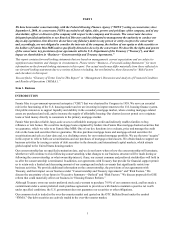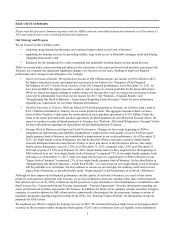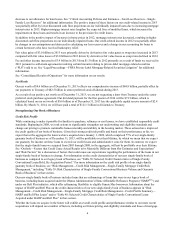Fannie Mae 2013 Annual Report Download - page 16
Download and view the complete annual report
Please find page 16 of the 2013 Fannie Mae annual report below. You can navigate through the pages in the report by either clicking on the pages listed below, or by using the keyword search tool below to find specific information within the annual report.11
agreement, dividend payments do not offset prior Treasury draws, and we are not permitted to pay down draws we have made
under the agreement except in limited circumstances. Accordingly, the current aggregate liquidation preference of the senior
preferred stock is $117.1 billion, due to the initial $1 billion liquidation preference of the senior preferred stock (for which we
did not receive cash proceeds) and the $116.1 billion we have drawn from Treasury.
Overall Market Conditions. We expect that single-family mortgage loan serious delinquency and severity rates will continue
their downward trend, but that single-family serious delinquency and severity rates will remain high compared with pre-
housing crisis levels. Despite steady demand and stable fundamentals at the national level, the multifamily sector may
continue to exhibit below average fundamentals in certain local markets and with certain properties. We expect the level of
multifamily foreclosures in 2014 will generally remain commensurate with 2013 levels.
We believe that the recent increase in mortgage rates will result in a decline in overall single-family mortgage originations in
2014 as compared with 2013, driven by a decline in refinancings. We forecast that total originations in the U.S. single-family
mortgage market in 2014 will decrease from 2013 levels by approximately 30% from an estimated $1.82 trillion to $1.28
trillion, and that the amount of originations in the U.S. single-family mortgage market that are refinancings will decrease
from an estimated $1.14 trillion in 2013 to $491 billion in 2014. Refinancings comprised approximately 70% of our single-
family business volume in 2013, compared with approximately 79% in 2012. Because we expect refinancings to decline in
2014, we expect that refinancings will constitute a smaller portion of our single-family business volume in 2014 than in 2013.
Home Prices. Based on our home price index, we estimate that home prices on a national basis increased by 8.8% in 2013.
Although we expect home price growth to continue in 2014, we expect the rate of home price growth on a national basis in
2014 will be lower than in 2013. Future home price changes may be very different from our expectations as a result of
significant inherent uncertainty in the current market environment, including uncertainty about the effect of recent and future
changes in mortgage rates; actions the federal government has taken and may take with respect to tax policies, spending cuts,
mortgage finance programs and policies and housing finance reform; the management of the Federal Reserve’s MBS
holdings; the impact of those actions on and changes generally in unemployment and the general economic and interest rate
environment; and the impact on the U.S. economy of global economic conditions. We also expect significant regional
variation in the timing and rate of home price growth.
Credit Losses. Our credit losses, which include our charge-offs, net of recoveries, reflect our realization of losses on our
loans. We realize losses on loans, through our charge-offs, at the time of foreclosure or when we accept short sales or deeds-
in-lieu of foreclosure. Our credit losses were $4.5 billion in 2013, down from $14.6 billion in 2012. We expect our credit
losses in 2014 and 2015 will be higher than 2013 levels. The amounts we recognized in 2013 pursuant to a number of
repurchase and compensatory fee resolution agreements reduced our 2013 credit losses from what they otherwise would have
been. Moreover, we expect our implementation of the charge-off provisions required by FHFA’s Advisory Bulletin AB
2012-02 in 2015 will increase our credit losses for 2015 from what they otherwise would have been. We expect our credit
losses to resume their downward trend beginning in 2016. See “Our Charter and Regulation of Our Activities—FHFA
Advisory Bulletin Regarding Framework for Adversely Classifying Loans” for further information about this Advisory
Bulletin.
Loss Reserves. Our total loss reserves consist of (1) our allowance for loan losses, (2) our allowance for accrued interest
receivable, (3) our allowance for preforeclosure property taxes and insurance receivables, and (4) our reserve for guaranty
losses. Our total loss reserves were $47.3 billion as of December 31, 2013, down from $62.6 billion as of December 31, 2012
and their peak of $76.9 billion as of December 31, 2011. We expect our loss reserves will continue to decline in 2014, but at a
slower pace than in 2013. Although our loss reserves have declined substantially from their peak and are expected to decline
further, we expect our loss reserves will remain elevated relative to the levels experienced prior to the 2008 housing crisis for
an extended period because (1) we expect future defaults on loans that we acquired prior to 2009 and the resulting charge-offs
will occur over a period of years and (2) a significant portion of our reserves represents concessions granted to borrowers
upon modification of their loans and our reserves will continue to reflect these concessions until the loans are fully repaid or
default.
Factors that Could Cause Actual Results to be Materially Different from Our Estimates and Expectations. We present a
number of estimates and expectations in this executive summary regarding our future performance, including estimates and
expectations regarding our future financial results and profitability, our future dividend payments to Treasury, our future
revenues, the profitability and performance of single-family loans we have acquired, our future acquisitions, our future
delinquency and severity rates, our future credit losses and our future loss reserves. We also present a number of estimates
and expectations in this executive summary regarding future housing market conditions, including expectations regarding
future mortgage originations and future home prices. These estimates and expectations are forward-looking statements based
on our current assumptions regarding numerous factors. Our future estimates of our performance and housing market
conditions, as well as the actual results, may differ materially from our current estimates and expectations as a result of: the
























